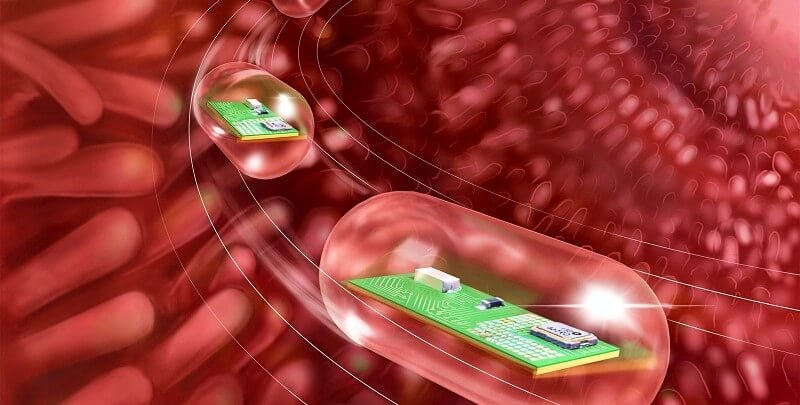The idea of journeying inside the human body to solve medical problems has been around at least since a hokey sci-fi film popularized the concept in the 1960s, but this approach to medicine has never become real because shrinking rays, sadly, do not exist.
However, researchers have developed proxies for human doctors that are small enough travel through the human body and help diagnose ailments. These “smart pills” are typically swallowed, and as they pass through the digestive tract, they collect health data, record images, and even deliver drugs.
But just like a delivery driver needs to know which street they are on to drop off a pizza at the right address, a smart pill must know its location in the body to do its job well. Now, a team of researchers from Caltech have developed a technological platform that they describe as a “GPS” for smart pills.
“Wireless localization of smart pills or other tiny devices deep inside the body, with high accuracy, is very challenging,” says Azita Emami, the Andrew and Peggy Cherng Professor of Electrical Engineering and Medical Engineering and executive officer for electrical engineering.
“But a low-cost solution can open new avenues in diagnosis and treatment of common medical conditions.”
Mikhail Shapiro, professor of chemical engineering and medical engineering and Howard Hughes Medical Institute investigator, says there are three possible ways to access locations inside the body to see what is going on.
“We can stick something in there like a colonoscopy device, cut the body open, or you can swallow a little pill that passes through you and makes the relevant measurements,” Shapiro says. “I think most people would choose the latter option if it provides the performance that is needed to diagnose and treat them.”
Caltech doctoral student Saransh Sharma developed this smart-pill technology with Emami and Shapiro, and it was tested in pigs in collaboration with researchers at MIT. A paper describing their work appears in the journal Nature Electronics.
The technology, which has been dubbed iMAG (Ingestible Microdevices for Anatomic-mapping of Gastrointestinal-tract) is not the first implementation of a trackable smart pill, but its creators say it is the most accurate and easiest to track yet developed.
Trackable smart pills are useful not just for their potential ability to deliver drugs to an exact location in the digestive tract—say, where a tumor is located—but also for a much lower-tech reason.
“We first wanted to monitor GI (gastrointestinal) tract motility,” Emami says. “There are a lot of people who have problems with slowdowns in the GI tract. A lot of times, physicians do not know where the slowdown is or even how things are moving in the GI tract.”
Emami says monitoring digestive tract motility has commonly required a patient to drink multiple “markers” and then get their abdomens X-rayed several hours or a day later to see how far the markers have moved.
“That doesn’t exactly show dynamic movement though,” she adds. “So what we are doing here shows real-time movement, but there is also possibility that in the future we could add drug delivery or sensing to the smart pill.”
Emami says previous attempts at real-time movement tracking of smart pills relied on what is known as RF triangulation. The pill was essentially a radio beacon. Although RF triangulation works, it cannot pinpoint the location of a smart pill with a resolution better than a few centimeters, which is not quite accurate enough when you are trying to pinpoint where a pill is sitting in the twists and turns of the intestines. On the other hand, iMAG pill has the potential to locate the pill with submillimeter accuracy, Emami says.
The researchers achieved this by tucking circuitry inside the pill that can detect the strength of magnetic fields. To go along with that, the team designed and built flat magnetic coils that create precise magnetic-field gradients. Because the properties of these magnetic-field gradients are so exact, the pill is able to determine where it is in relationship to the coils by sensing the strength of the magnetic field. The pill then broadcasts this information wirelessly via Bluetooth to a nearby smartphone.
For the purposes of collecting data for research conducted with pigs, the researchers placed the coils on a chute that the pigs walked through. But the technology is small and portable enough that it could be integrated into a jacket or a backpack, which means that data from a pill ingested by a human patient could be collected all day long, wherever the patient might be.
“This is such an easy-to-use device compared to an X-ray or MRI, so a patient can take it home with them,” Sharma says. “A lot of effort has gone into designing it so there is no issue with the patient compliance or being worried that it is hard for them to use it.”
Emami says future research will focus on making the pills even more precise, less expensive, and giving them the ability to release drugs or take other actions in response to an external signal. She also hopes to eventually see the pills used during surgery—to reveal the exact location of a tumor, for example.
The paper describing the iMAG technology is titled “Location-aware smart-pills for wireless monitoring of gastrointestinal dynamics,” and it appears in the February 13 issue of Nature Electronics. Co-authors are electrical engineering graduate students Saransh Sharma (MS ’18) and Fatemeh Aghlmand (MS ’19); Margaret B. Swift, research manager for the Shapiro Lab; Nikhil H. Poole (BS ’20); Khalil B. Ramadi of New York University, Shriya S. Srinivasan, Keiko Ishida, Johannes Kuosmanen, and Giovanni Traverso and Josh Jenkins of MIT.
Funding for the research was provided by the National Science Foundation, Caltech’s Rothenberg Innovation Initiative, and the Heritage Medical Research Institute.


